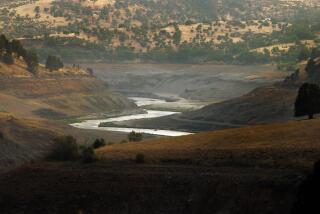Economy-Boosting Effort in Japan Isn’t Worth a Dam
- Share via
TOKYO — Imagine that an American city held a referendum on whether to build a billion-dollar dam and residents voted more than 10 to 1 against it--but the government refused to abandon its construction plans.
Japan is in a furor over just such a scenario. It began Sunday when residents of the city of Tokushima voted 102,759 to 9,367 against building a dam across the Yoshino River on the island of Shikoku.
And it escalated today when it was reported that the construction minister intended to go forward with the dam despite the opposition. “As long as the experts don’t revise their views, I am in no position to change my stance,” Construction Minister Masaaki Nakayama said.
What has rocked the political establishment here is not only the size of the anti-dam vote but the reasons behind it. Exit polls found that, while environmental concerns were a factor, the primary motive for rejecting the $980-million dam project was that voters deemed it a waste of taxpayers’ money.
The referendum is not legally binding, and it remains to be seen if the Construction Ministry can force through the project despite massive opposition. Either way, the landslide “no” vote is seen as a rebuke to Japan’s “bureaucrats know best” style of governance.
It is also seen as a symptom of citizens’ mounting concern that the Liberal Democratic Party’s policy of trying to revive the stagnating Japanese economy by spending world-record sums on public works will leave Japan with huge debts and little enduring benefit.
Since 1992, Japan has spent more than $1 trillion in the effort to prime the pump of its ailing economy, and the spending spree continues. Japan’s budget for fiscal 2000 is a mammoth $809 billion and will produce the nation’s largest deficit in history.
Meanwhile, the Japanese national debt has skyrocketed, from 62% of the gross domestic product in 1983 to 97% of GDP in 1998. And projections are that it will jump to 122% of GDP by 2001, according to a recent report by the Organization for Economic Cooperation and Development.
By contrast, the U.S. national debt, which exploded in the 1980s, will drop from 62% of GDP in 1998 to 55% in 2001, the OECD forecast. And most other developed nations, including former spendthrift Italy, are also whittling down their public debt.
Despite Japan’s mounting debt, ever since the 1997 Asian economic crisis, the United States has been flogging Tokyo to restructure its economic house in order to prevent the ailing No. 2 economy from slipping into a coma and dragging the world into recession.
Some financial analysts argue that, for technical reasons, Japan’s public debt is not as ominous as it seems. Unlike the U.S. national debt, which is mainly held by the Japanese and other foreigners, Japanese debt is mainly held by domestic investors.
These bondholders are famously forgiving and have so far been willing to accept a paltry return from rock-bottom interest rates. But some economists, officials and businesspeople fear that Japanese interest rates are bound to rise. If so, the cost of servicing the national debt will balloon.
Now that the economy appears to be no longer in critical condition, more Japanese are beginning to fret, both about the size of the bill coming due and about whether they’ve gotten their yen’s worth.
In a December poll by the Yomiuri newspaper, 60% of those surveyed were dubious about or opposed to relying on public works spending to revive the economy. This month, two of Prime Minister Keizo Obuchi’s most powerful LDP rivals, Koichi Kato and Seiroku Kajiyama, began arguing that more public works spending will not improve the Japanese economy or the LDP’s political fortunes.
According to Takayoshi Igarashi, a professor of public works theory at Hosei University in Tokyo, 60% of Japan’s national debt is the legacy of public construction. Igarashi, perhaps Japan’s best-known critic of pork-barrel practices, has published a list of the country’s 100 most wasteful public works projects, and he estimates that these alone have cost Japanese taxpayers more than $76 billion.
Traditionally, it is urban voters who have been most disenchanted at seeing their taxes used disproportionately to pay for construction projects in the LDP’s rural strongholds.
But recently, feisty local citizens movements in depopulating rural areas have also begun questioning the wisdom of building expensive new roads and tunnels, bridges and airports that will rarely be used, or dams such as the one proposed for Tokushima.
“These projects will never generate enough money to pay even the interest on the bonds,” Igarashi said Tuesday. “Billions and billions [of dollars] have been wasted. . . . This is placing huge pressures on the Japanese economy that will eventually crush us.”
The Tokushima referendum was only the 10th plebiscite ever in this country. The first referendum was held in 1996 by a town that successfully rejected plans for a nuclear power plant, and other towns have since voted down hazardous waste facilities and incinerators.
Tokushima residents are the first voters to reject a construction project of the sort that rural areas used to vie for. The vote is expected to encourage groups elsewhere in Japan to try to use referendums to derail other pricey or unpopular projects.
The Tokushima dam is by no means dead, however, although it may end up elsewhere along the Yoshino River, said pollster Yoshiaki Kobayashi.
The Construction Ministry says the area is likely to flood once every 150 years and wants to remove a pile of stones that were placed in the river for flood control about 250 years ago and build an automated modern dam.
Officials insist that Tokushima residents should not be able to use a referendum to veto a project that has public safety implications for their neighbors up- and downstream.
Dam foes say the construction would be environmentally damaging and completely unnecessary.
“In 250 years, there has never been a [flooding] problem here, and there is no evidence that there is any need for a dam now,” Masayoshi Himeno, leader of the anti-dam campaign, said in a telephone interview from Tokushima.
Himeno criticized the government’s response to the referendum as condescending. Several officials and editorialists have suggested that voters did not understand the technical details of flood control and that opposition to the dam could be blunted by a public education campaign.
But Himeno said the Construction Ministry held more than 100 public meetings to explain why the dam is needed--and the more residents heard, the more they rejected the official line.
If the government wants to spend to stimulate the local economy, he said, residents would prefer to see the money go into nursing care for the fast-growing elderly population--or the retrofitting of 100 local bridges that lie on a major earthquake fault. To date, citing budget restrictions, authorities have reinforced only three of them, Himeno said.
More to Read
Sign up for Essential California
The most important California stories and recommendations in your inbox every morning.
You may occasionally receive promotional content from the Los Angeles Times.













